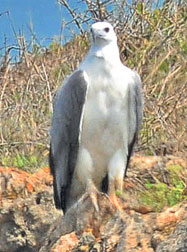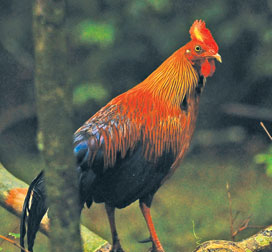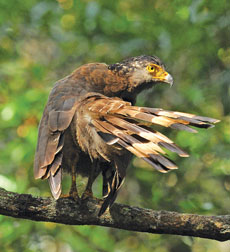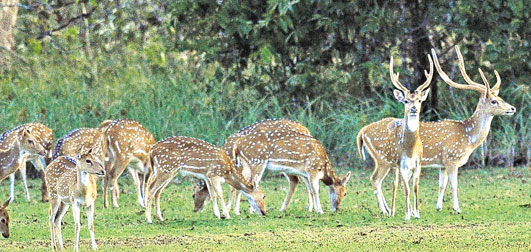In Magical Wilpattu
By Mahil Wijesinghe
 |
|
View of Kali
Villu, one of the 40 villu in Wilpattu |
A constant drizzle followed us on the way, but it was magical to feel
the rush of the monsoon in the jungle. Dark, low-hanging clouds,
pregnant with rain, dotted the sky. The parched jungle was only too
willing to embrace the downpour. The jungle looked bewitching, but we
were on unfamiliar terrain. We took a detour and reached the main
entrance of Wilpattu National Park around 6.30 on a gloomy morning.
Wilpattu means 'the land of the villus', deriving its name from the
abundant natural lakes (Vila in Sinhala; Villu in Tamil).
This huge, 131,693 hectare national park lies along the north-western
coast, between the rivers Modaragam Aru and Kala Oya. We were a
five-member team comprising Susantha, an avid wildlife photographer,
Asitha, Indika, Chinthaka, with his 4DR5 Mitsubishi jeep and myself. We
entered the park with a young tracker, Asela who joined us from the park
office.
We stayed at the charming two-storey Kokmottai wildlife bungalow in
the park, managed by the Wildlife Department. Set across the thick
jungle along a tributary of the scenic Kala Oya, the bungalow offered
genuine nature's hospitality. The dining table and chairs adorned the
front and ground floor. The interiors enhanced the cheerful atmosphere
while the attached toilets were basic and clean. The resourcefully
built, open-to-the-sky balcony on the upper floor was a talking point
and the wooden flooring and wood-panelled rooms took our breath away.
 |
|
Bodilima |
Our first morning started with wonderful views of brightly coloured,
handsome, jungle fowls, the national bird of Sri Lanka. The park is rich
in avian life - both forest birds and water birds. Wilpattu is an
infinite treasure trove of innumerable species of trees, plants and
wildlife including leopards, sloth bears, jackals, barking deer, sambar
and spotted deer. Its pristine eco-system is endowed with a rich
biodiversity and contains beautiful white sandy forest tracks.
It has
mainly thick secondary forest. One of the unique features of the park's
topography is the concentration of villus, basin-like shallow natural
tanks, where large flocks of water birds and herds of wild boar and
spotted deer constantly roam. They are also home to the Mugger
crocodile.
There are about 40 magnificent villus within the Wilpattu National
Park, some of which are salty, ideal for wading birds. Kokkari Villu,
the largest contains salt water and has a maximum depth of 10 feet while
Maila Villu is the second largest at the park. The historic Kali Villu
is associated with the legend of Kuveni; it's believed that she got
water from it.
Thick forest
 |
 |
| The white-bellied sea
eagle |
Changeable hawk eagle |
The thick forest of Wilpattu is a haven for various birds such as the
Crested Serpent Eagle, Grey-headed Fish Eagle, Changeable Hawk Eagle and
White-bellied Sea Eagle and a variety of mammals and reptiles.
After a long, bumpy drive under a canopy of huge Palu and Weera trees
and white sandy tracks around the villus, we spotted eagles waiting on
tree tops for their prey. Soon we were rewarded with sightings of other
birds such as Black-tailed Godwit, Lesser Sand Plover, Golden Plover and
Green and Marsh Sandpiper at the small and beautiful Kuda Patessa Villu,
which contains white sand dunes with marshy edges.
Upon encountering an animal or bird in the park, Chinthaka switched
off the jeep engine and the stillness of the air was broken only by the
steady click of Susantha's camera.
The second day was dedicated to visit Kudiramalai point, the highest
hill in this range where reddish sand dunes spread up to the Western
coast. This was the place where Prince Vijaya is believed to have landed
in Sri Lanka.
 |
|
The leopard crossing
the track in Wilpattu |
We passed the huge Maila Villu, close to the sea, where we
glimpsed the White-bellied Sea Eagle, a large bird whose nesting and
breeding were recorded in this part of Wilpattu.
The highlight of the day was encountering two young leopards in a
thicket! One seemed to be marking his territory after the rain. Our
endeavour proved productive with the spotting of the leopard.
Spotted deer
Later, we saw plenty of spotted deer, sambar, monitors and birds such
as green pigeons, emerald doves, painted storks and eagles and a
bodilima lizard. A pair of Malabar Pied Hornbills was also sighted. The
animals were not yet accustomed to the sound of vehicles.
 |
 |
| A jungle fowl |
A serpent eagle |
We waited
until the deer emerged from the bushes and walked down to the villu with
a distinct swagger as if they knew the whole world was looking at them.
They sat on their hind-legs and gave us the perfect picture that
Susantha and Indika recorded through telephoto lenses.
On the third day, we were determined to see the elusive sloth bear.
Asela said that there are around 100 of them in Wilpattu. In the morning
we travelled to Ochappu Kallu, known for its rocky mountains and caves
where bears can be easily spotted.
We scanned the vast expanse for a
glimpse of the bear. Asela took us to numerous places in the park from
Walasgala to Maradanmaduwa tank, but the bear was not sighted.
The park remains beautiful and unspoilt today despite the gruesome
and tragic events recorded in the recent past. The LTTE destroyed
several bungalows and killed Wildlife officers as well as visitors to
the park during the height of their terror.
The park remained closed
with only the main office open. With the dawn of peace, the park
reopened on February 2010.
Park Warden Manoj Vidyaratne tries his best to uplift the conditions
of the park and add more modern facilities for tourists by building and
renovating circuit bungalows and roads. The guides have been trained to
bring the jungle experience to the visitors and help them take delight
in the varied flora and fauna that the Wilpattu National Park is endowed
with.
 |
 |
| The Malabar hornbill |
A herd of spotted deer
in the villu |
Pix: Susantha
Wijayagunasekera
|

